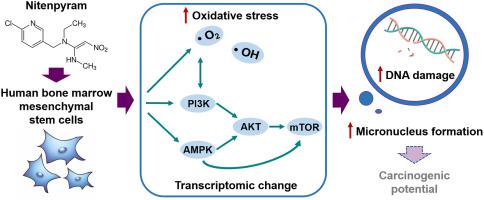Toxicology and Applied Pharmacology ( IF 3.3 ) Pub Date : 2022-05-11 , DOI: 10.1016/j.taap.2022.116065 Wei Liu 1 , Zechang Li 1 , Xiaoyu Cui 1 , Fang Luo 1 , Chunyan Zhou 1 , Jiangyu Zhang 1 , Liguo Xing 2

|
Despite of the global contamination and ubiquitous exposure to nitenpyram (NIT), little knowledge is available on the adverse effects to human health, with some evidence referring to its genotoxic potency to non-target organisms and esophageal squamous papilloma in rats. Human bone marrow mesenchymal stem cells (hBMSCs) was employed as an in vitro model more relevant to humans to assess the potential genotoxicity of NIT and to understand the underlying mechanisms at cellular and molecular levels. Noncytotoxic concentrations of NIT, 50–2500 μg/mL, dose-dependently elevated micronucleus (MN) and nuclear bud (NB) frequencies to 8.7–29‰ and 15–35‰, respectively. Additional metabolism by rat liver S9 fraction decreased chromosome impairment by 27–52% on MN frequencies and 63–76% on NB frequencies. A commercial NIT product, containing 20% of NIT and 60% of pymetrozine, caused higher cytotoxicity and chromosome impairment in comparison with NIT alone. Expressions of genes responses to DNA damage, ATM, ATR, p53, p21, Bax, H2AX, and GADD45A were disturbed by NIT treatment. Reactive oxygen species (ROS) amount and superoxide dismutase (SOD) activity were enhanced by NIT. Comet assay showed that lower concentrations of NIT, 12.5–100 μg/mL, induced the DNA damage. Transcriptomic analysis identified 468 differentially expressed genes (p < 0.05, |log2(Foldchange)| ≥ 1), from which 22 pathways were enriched. Multiple affected pathways were related to cancer including viral carcinogenesis and bladder cancer. NIT may produce genotoxicity via inducing oxidative stress and deregulating PI3K/Akt, AMPK and mTOR signaling pathways, associated with carcinogenetic potency. While environmental levels of NIT alone may pose little risk to human health, attention should be paid to the health risk arose from the synergistic or additive effects that may exist among NEOs and other types of pesticides.
中文翻译:

烯啶虫胺对人骨髓间充质干细胞的基因毒性、氧化应激和转录组学影响
尽管全球污染和普遍暴露于烯啶虫胺 (NIT),但对人类健康的不利影响知之甚少,一些证据表明其对非靶标生物和大鼠食管鳞状乳头状瘤的遗传毒性效力。人骨髓间充质干细胞 (hBMSCs) 被用作与人类更相关的体外模型,以评估 NIT 的潜在遗传毒性并了解细胞和分子水平的潜在机制。NIT 的非细胞毒性浓度为 50-2500 μg/mL,微核 (MN) 和核芽 (NB) 频率呈剂量依赖性升高,分别为 8.7-29‰ 和 15-35‰。大鼠肝脏 S9 部分的额外代谢使 MN 频率的染色体损伤降低了 27-52%,NB 频率降低了 63-76%。一种商业 NIT 产品,与单独的 NIT 相比,含有 20% 的 NIT 和 60% 的吡蚜酮会导致更高的细胞毒性和染色体损伤。基因表达对 DNA 损伤的反应,ATM、ATR、p53、p21、Bax、H2AX和GADD45A受到 NIT 处理的干扰。NIT 增强了活性氧 (ROS) 的数量和超氧化物歧化酶 (SOD) 的活性。彗星试验表明,较低浓度的 NIT(12.5-100 μg/mL)会诱导 DNA 损伤。转录组分析鉴定出 468 个差异表达基因(p < 0.05, |log2(倍数变化)| ≥ 1),从中富集了 22 条通路。多种受影响的途径与癌症有关,包括病毒致癌和膀胱癌。NIT 可能通过诱导氧化应激和解除对 PI3K/Akt、AMPK 和 mTOR 信号通路的调节而产生遗传毒性,这与致癌效力相关。虽然仅 NIT 的环境水平可能对人类健康造成的风险很小,但应注意近地天体和其他类型农药之间可能存在的协同或相加效应所产生的健康风险。


















































 京公网安备 11010802027423号
京公网安备 11010802027423号